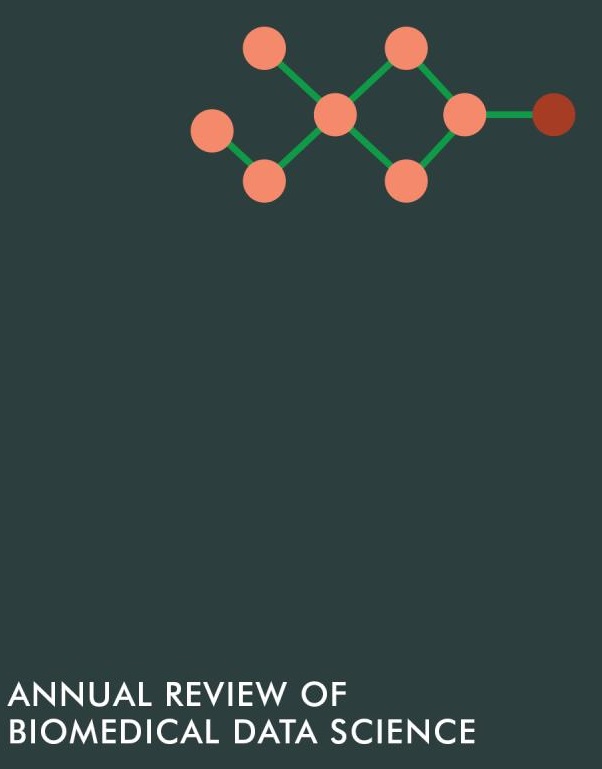什么是生物医学数据科学?我们需要对其进行年度审查吗?
IF 7
Q1 MATHEMATICAL & COMPUTATIONAL BIOLOGY
Annual Review of Biomedical Data Science
Pub Date : 2018-07-20
DOI:10.1146/ANNUREV-BD-01-041718-100001
引用次数: 8
摘要
我们很高兴为您带来《生物医学数据科学年度评论》的第一卷。它涵盖了一系列生物和医学研究挑战,这些挑战是数据密集型的,重点是创造新的方法来推进生物医学科学的发现。“数据科学”一词描述了与获取(通常是大型)数据集以及注释、清理、组织、存储和分析数据集以提取知识相关的专业知识。它融合了统计学、计算机科学和计算工程的学科。许多人对这个词感到恼火——所有的科学最终都取决于数据,上面列出的许多活动听起来像是工程(关于解决问题),而不是科学(关于发现新知识)。如果“数据科学”不是关于科学的,而形容词“数据”没有特别的含义,为什么这个词会存在?事实上,信息学的相关领域已经以多种形式存在了几十年——医学信息学、临床信息学、健康信息学、生物信息学和生物医学信息学——而变体都指的是在生物学和医学领域内分析数据、信息和知识的方法的发展。这些领域的从业者很快指出,如果不是全部的话,大多数数据科学都属于信息学的范畴。信息学是一个广泛的领域,包括与数据、信息和知识互动的社会方面;人机界面的挑战;以及将破坏性的新计算干预引入具有现有工作流程的系统(如医院和实验室)的相关问题。那么,为什么有必要为该领域引入一个新名称呢?“数据科学”一词已经得到了认可,人们对它的普遍认同表明它有着有用的用途。在这里,我们对这个名字在许多活动中的不同使用提出了一些看法:本文章由计算机程序翻译,如有差异,请以英文原文为准。
What is Biomedical Data Science and Do We Need an Annual Review of It?
We are pleased to bring you the first volume of the Annual Review of Biomedical Data Science. It spans a range of biological and medical research challenges that are data intensive and focused on the creation of novel methodologies to advance biomedical science discovery. The term “data science” describes expertise associated with taking (usually large) data sets and annotating, cleaning, organizing, storing, and analyzing them for the purposes of extracting knowledge. It merges the disciplines of statistics, computer science, and computational engineering. Many are irritated by the term—all of science depends ultimately on data, and many of the activities listed above sound like engineering (which is about solving problems) and not science (which is about discovery of new knowledge). If “data science” is not about science and the adjective “data” has no particular meaning, why does this term exist? Indeed, the allied fields of informatics have existed for several decades in many forms—medical informatics, clinical informatics, health informatics, bioinformatics, and biomedical informatics—and variants all refer to the development of methods to analyze data, information, and knowledge within the space of biology and medicine. Practitioners of these fields are quick to point out that most if not all of data science falls within the purview of informatics. Informatics is a broad field that includes the social aspects of interacting with data, information, and knowledge; the challenges of human–computer interfaces; and the issues associated with introducing disruptive new computational interventions into systems (like hospitals and laboratories) with existing workflows. So why is the introduction of a new name for the field necessary? The term “data science” has gained recognition, and the widespread comfort with it suggests it serves a useful purpose. Here we offer some observations on the diverse use of the moniker for many activities:
求助全文
通过发布文献求助,成功后即可免费获取论文全文。
去求助
来源期刊
CiteScore
11.10
自引率
1.70%
发文量
0
期刊介绍:
The Annual Review of Biomedical Data Science provides comprehensive expert reviews in biomedical data science, focusing on advanced methods to store, retrieve, analyze, and organize biomedical data and knowledge. The scope of the journal encompasses informatics, computational, artificial intelligence (AI), and statistical approaches to biomedical data, including the sub-fields of bioinformatics, computational biology, biomedical informatics, clinical and clinical research informatics, biostatistics, and imaging informatics. The mission of the journal is to identify both emerging and established areas of biomedical data science, and the leaders in these fields.

 求助内容:
求助内容: 应助结果提醒方式:
应助结果提醒方式:


